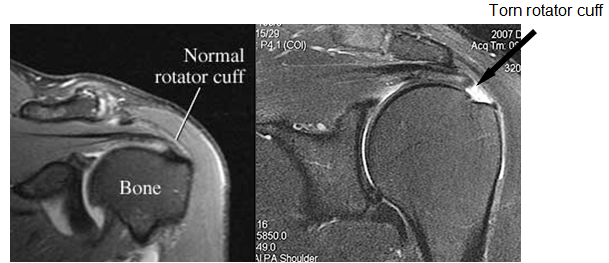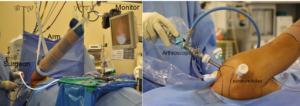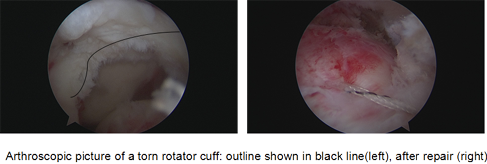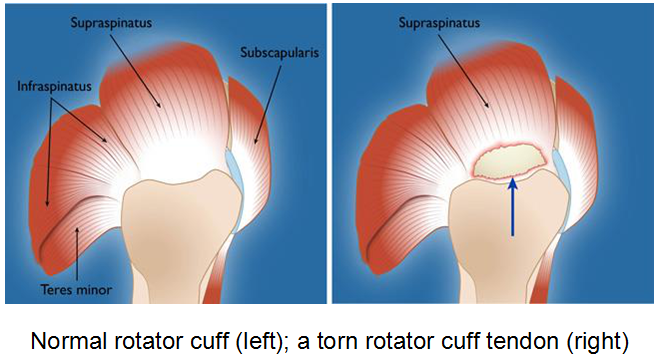Rotator cuff tears is one of the most common causes of shoulder pain. A torn rotator cuff can also cause weakness of the shoulder.
What is a rotator cuff tear?

Our shoulder joint is like a ball (the upper end of the humerus bone) and socket (glenoid). The ball is larger than the socket. The Rotator Cuff muscles are those muscles that surround the shoulder joint. There are four muscles, which combine to form a sheet of tendon and attach on to the upper end of the humerus bone.Their job is to provide the power to lift and rotate the arm and to make sure the ball is within the socket while moving the shoulder.
As one ages these muscles become thinner and are prone to rupture, sometimes with minimal injury. Unfortunately when the Rotator Cuff muscles tears completely they do not repair themselves. Leaving them unattended can lead to progression of the tear. As the tear becomes larger, there can be progressive loss of motion and power in the shoulder. The longer a large tear is left ,the bigger it gets and the more motion and power one loses. Also, the surgical result is likely to be better with a smaller tears than a larger tears and thus it is better to address them in earlier stages.
A rotator cuff tear can happen either because of injury (acute) or due to degeneration (chronic wear and tear). Acute tears can happen when you fall on an outstretched hand or lift something heavy. You may have even heard a crackling noise when you had the injury. The chronic ones usually do not give a history of injury. They happen over a period of time, sometimes due to normal wear and tear or due to repetitive stress or sometimes due to a bony spur.
- Pain at rest and at night, particularly if lying on the affected shoulder
- Pain when lifting and lowering your arm or with specific movements
- Weakness when lifting or rotating your arm
- Crepitus or crackling sensation when moving your shoulder in certain positions
- Eventually you may loose majority of shoulder function
 To diagnose a rotator cuff tear, your surgeon performs a thorough physical examination. He may request you for radiological investigations like Xrays or MRI scans. The first investigation is usually a Xray. Most of the times the X-rays turn out to be normal, except for a spur. This is because the soft tissues are not seen on the X-ray. MRI scans give us a very good idea of the rotator cuff tear. They can tell us the size and thickness of the tear, the condition of the muscles and also if the tear is old or new.
To diagnose a rotator cuff tear, your surgeon performs a thorough physical examination. He may request you for radiological investigations like Xrays or MRI scans. The first investigation is usually a Xray. Most of the times the X-rays turn out to be normal, except for a spur. This is because the soft tissues are not seen on the X-ray. MRI scans give us a very good idea of the rotator cuff tear. They can tell us the size and thickness of the tear, the condition of the muscles and also if the tear is old or new.
If you have a rotator cuff tear and you keep using your shoulder despite increasing pain, you may cause further damage. A rotator cuff tear can get larger over time and ultimately lead to a compromised outcome.The goal of any treatment is to reduce pain and restore function. There are several treatment options for a rotator cuff tear, and the best option is different for every person. It depends on your age, activity level, general health, and the type of tear you have. Non operative management gives good results in smaller or partial tears provided the demand on the shoulder is not high. Non operative treatment consists of physical therapy, pain medications and sometimes, injections into the shoulder. If, however, the tears are moderate to large or the functional deficit is significant then surgery is required.
You doctor may recommend surgery in one/ more of the below mentioned situations:
- Your symptoms have lasted for more than 6 to 12 months
- You have a large tear
- You have significant weakness and loss of function in your shoulder
- Your tear was caused by a recent, acute injury
- Arthroscopy (key hole operation) have made rotator cuff surgeries more effective and reliable. The results are excellent with the other advantages of key hole surgeries like shorter hospital stay, less pain, less scar and quicker rehabilitation.
What are the Surgical treatment options?
These tears can be repaired using both open and arthroscopic techniques (key hole surgery). The type of repair performed depends on several factors, including your surgeon’s experience and familiarity with a particular procedure, the size of your tear, your anatomy, and the quality of the tendon tissue and bone.Success Story: Rotator Cuff Tears
You may have other shoulder problems in addition to a rotator cuff tear, such as biceps tendon tears, osteoarthritis, bone spurs, or other soft tissue tears. During the operation, your surgeon may be able to take care of these problems, as well.
The advances in arthroscopy has made the treatment of rotator cuff tears more effective and the outcomes have been very reliable. The arthroscopic (key hole) procedure (repair) gives excellent results in most cases of rotator cuff tears and the other advantage of doing it arthroscopically is less post operative pain and quicker rehabilitation. The goal of the operation is to repair the torn muscle to the part of the bone from which it has become detached.
What is arthroscopy?
 Arthroscopy literally means visualization of the joint. It is commonly known as key hole surgery. In this procedure the surgeon uses 4-5 very small incisions (holes) around the shoulder. One of the holes can be used to visualize the joint using a camera. Through the other holes, the surgeon uses pencil thin instruments by which the repair will be accomplished.
Arthroscopy literally means visualization of the joint. It is commonly known as key hole surgery. In this procedure the surgeon uses 4-5 very small incisions (holes) around the shoulder. One of the holes can be used to visualize the joint using a camera. Through the other holes, the surgeon uses pencil thin instruments by which the repair will be accomplished.
What are the advantages of arthroscopic procedure?
 An arthroscopic procedure is usually performed as a day care procedure. It involves very small incisions, and hence very less scarring. It is less painful and hence you may expect quicker recovery.
An arthroscopic procedure is usually performed as a day care procedure. It involves very small incisions, and hence very less scarring. It is less painful and hence you may expect quicker recovery.
What exactly happens during surgery?
 The torn cuff is initially visualized and assessed with the camera(arthroscope). Repair is then performed using small screws (anchors), to which threads are attached. Repair involves reattaching the torn tendon to the bone.
The torn cuff is initially visualized and assessed with the camera(arthroscope). Repair is then performed using small screws (anchors), to which threads are attached. Repair involves reattaching the torn tendon to the bone.
What happens after the operation?
Following the operation, You will rest your arm in a sling. After surgery do not attempt to lift or rotate the arm. It is important to sit out of bed and walk around as soon as you are comfortable and able.
The next day you will commence the exercise program under the supervision of a physiotherapist. The rotator cuff muscle takes 6 weeks to heal to the bone. If the muscles do contract in the first 6 weeks the repair may be torn apart. Exercises are started early to avoid stiffness of the shoulder following the operation. It is normal for the exercises to cause some discomfort.
On the day after surgery you will be discharged from hospital. In the immediate postoperative period you will experience pain about the shoulder. There will also be significant pain at night as a result of the surgery. On discharge from hospital you will be given pain killers as well as tablets to help you sleep at night.
You will then need to start a physiotherapy programme, which will continue for the next few months. It will involve exercises to improve the mobility and strength of the shoulder. Heavy lifting or overhead activity is not allowed for 6 to 9 months. Full function is allowed at 6 to 9 months providing there has been an adequate return of power.
Physiotherapy will take at least 6 months to achieve a full or near full return of function. It is not uncommon for complete pain relief to require at least 6 to 9 months of rehabilitation following surgery.
What is the outcome after a rotator cuff repair?
The majority of patients report improved shoulder strength and less pain after surgery for a torn rotator cuff.
Factors that may decrease the likelihood of a satisfactory result include:
-
- Poor tendon/tissue quality
- Large or massive tears
- Poor patient compliance with rehabilitation and restrictions after surgery
- Smoking
What are the complications of rotator cuff repairs:
Complications during/ after an arthroscopic repair are rare. The surgery does not involve large incisions and blood loss. The chance of infection is rare. very small percentage of patients may experience complications like stiffness and re-tear.


